Net Zero Emissions: What It Means for Businesses and Why It Matters
In today’s rapidly changing world, Net Zero is no longer just an environmental slogan. It has become a boardroom priority worldwide
reshaping how companies plan, operate, and grow. From global investors to local regulators, the call for net zero emissions is louder than ever — and businesses that fail to adapt risk being left behind.
The challenge is clear: climate change is accelerating, governments are tightening policies, supply chains are demanding accountability, and customers are choosing brands with a zero carbon footprint. Achieving net zero carbon emissions is not simply about reducing environmental impact — it is about building resilience, unlocking new market opportunities, and safeguarding long-term profitability.
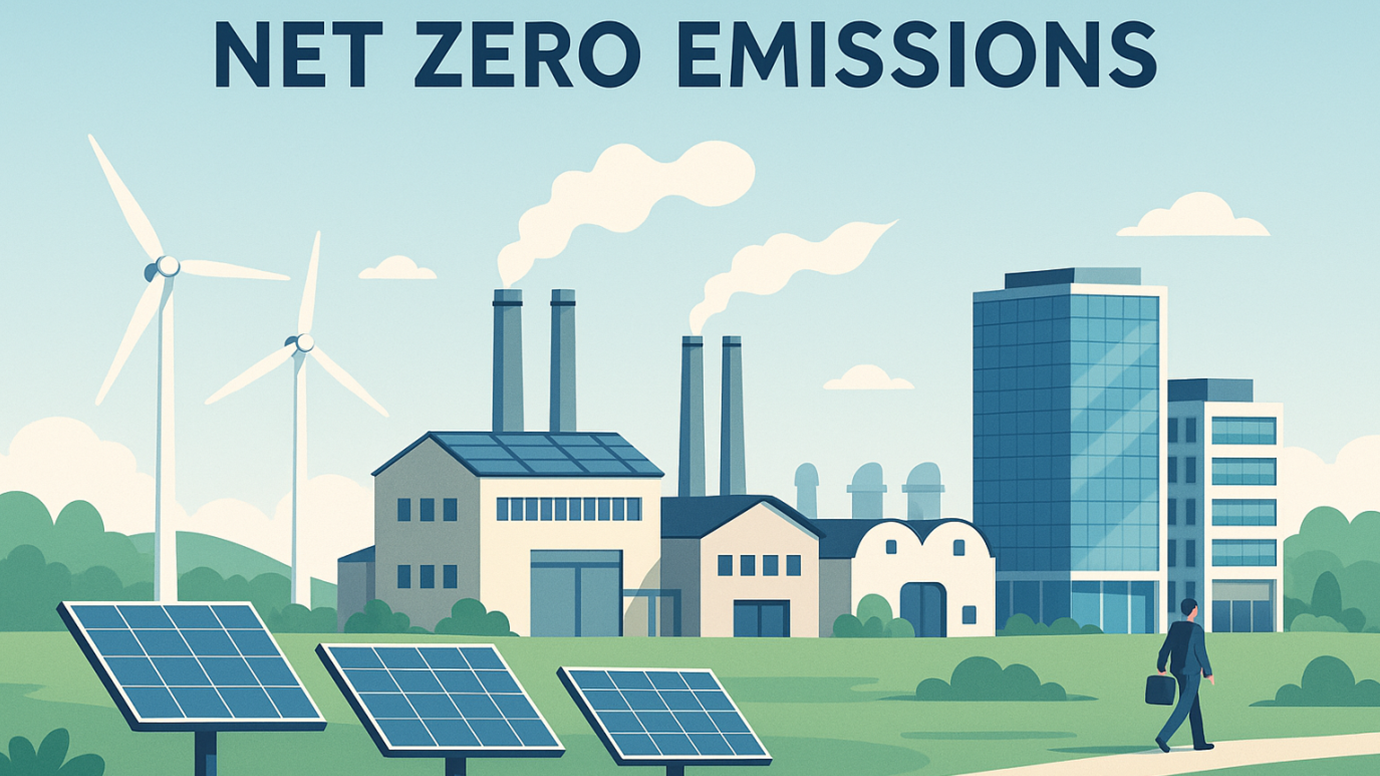
Whether you are exploring net zero energy solutions, designing a net zero building, or striving for zero carbon emissions across your operations, the journey is both urgent and essential.
In this blog, we’ll break down what net zero truly means, why it matters for businesses of all sizes, and how forward-thinking leaders can start reducing their carbon emissions today. By the end, you’ll see that the path to net zero emissions is not just a compliance exercise — it’s a transformative opportunity to build sustainable growth and future-proof your business.
What Does Net Zero Actually Mean?
At its core, Net Zero refers to achieving a balance between the greenhouse gases we put into the atmosphere and the amount that is removed or offset. In simpler terms, it means cutting emissions as much as possible and then neutralizing the small amount that remains through technologies or natural solutions. This balance is what we call net zero emissions.
It’s important to understand the distinction between carbon neutrality and net zero carbon emissions. While carbon neutrality typically focuses on offsetting emissions (for example, planting trees to absorb carbon), Net Zero goes further by requiring deep reductions in actual emissions before any offsetting takes place. In other words, it’s not just about compensating for pollution — it’s about transforming operations, infrastructure, and energy use to actively achieve lower carbon emissions.
Globally, the commitment to a zero carbon future has been cemented through the Paris Agreement, where nations pledged to limit global warming to 1.5°C. Many countries have set ambitious timelines: the European Union and the United States aim for net zero carbon emissions by 2050, China by 2060, and India by 2070. These pledges underline a clear message — the transition to zero carbon emissions is now a global priority. Learn more about the timelines and strategies shaping the global transition by visiting our dedicated article on Net Zero Targets.
For businesses, this commitment translates into new opportunities and responsibilities. From developing net zero buildings that consume less energy, to adopting net zero energy solutions such as solar and wind, organizations are expected to innovate and lead. A net zero energy building, for instance, is designed to generate as much clean energy as it consumes, effectively leaving behind a zero carbon footprint.
In short, Net Zero is not just an environmental goal — it’s a comprehensive framework for businesses to align with international targets, stay competitive in global markets, and contribute to a sustainable, resilient economy.
Why Net Zero Matters for Businesses?
For today’s businesses, the journey to net zero is no longer optional — it is a strategic necessity. Companies that embrace net zero emissions are not just responding to environmental challenges, but also positioning themselves to thrive in a competitive and highly regulated global economy. Here’s why it matters:
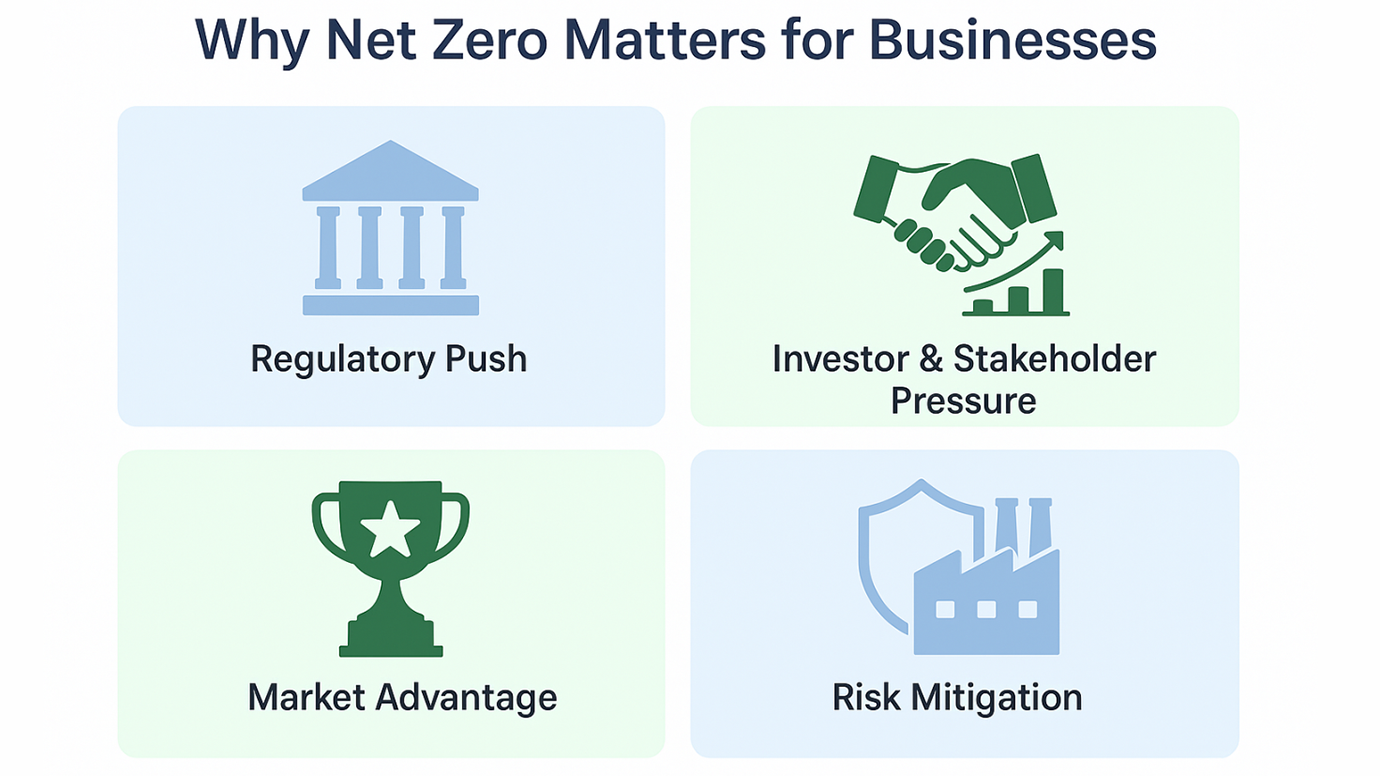
Regulatory Push
Governments around the world are tightening climate regulations to accelerate the transition toward zero carbon emissions. The Paris Agreement and country-specific pledges — including India’s target of achieving net zero carbon emissions by 2070 — are reshaping compliance requirements. Businesses now face stricter disclosure rules on sustainability performance, rising carbon pricing mechanisms, and mandatory ESG reporting. Whether it’s designing a net zero building, improving supply chains, or shifting to renewable sources, companies that act early will find it easier to meet these evolving regulatory standards while avoiding costly penalties.
Investor & Stakeholder Pressure
Investors, lenders, and stakeholders are increasingly aligning portfolios with sustainable practices. ESG investments are growing rapidly, and supply-chain leaders are demanding proof of lower carbon emissions from their partners. For example, initiatives like the EU’s Carbon Border Adjustment Mechanism (CBAM) require exporters to demonstrate reductions in zero carbon footprint products and services. Businesses that fail to show credible pathways to net zero emissions risk losing contracts, investment, and long-term stakeholder trust.
Market Advantage
Sustainability is no longer just a moral choice — it is a business differentiator. Companies that demonstrate genuine progress toward net zero gain a competitive edge in winning tenders, building stronger reputations, and attracting climate-conscious customers. A net zero building is not only an engineering achievement but also a brand statement that resonates with clients and communities. By innovating in net zero energy solutions, businesses unlock new revenue streams and appeal to markets that prioritize zero carbon products and services.
Risk Mitigation
The risks of ignoring the path to net zero emissions are substantial. From climate-related disruptions such as floods and heatwaves to the financial volatility of fossil fuel markets, businesses face significant exposure. Without decisive action, companies may be burdened with stranded assets, higher operational costs, and reputational damage. Transitioning to zero carbon emissions reduces dependency on volatile energy markets, while adopting net zero energy systems ensures long-term stability and resilience. Ultimately, achieving a zero carbon footprint is not only about protecting the planet — it’s about safeguarding business continuity.
In today’s environment, companies that embed net zero into their strategy are not only future-proofing their operations but also creating lasting value for stakeholders.
The Business Case: Opportunities Beyond Compliance
For forward-thinking organizations, the shift to net zero is not just about meeting government regulations — it is a powerful opportunity to drive growth, innovation, and resilience. Companies that actively work toward net zero emissions are discovering tangible business benefits that extend far beyond compliance.
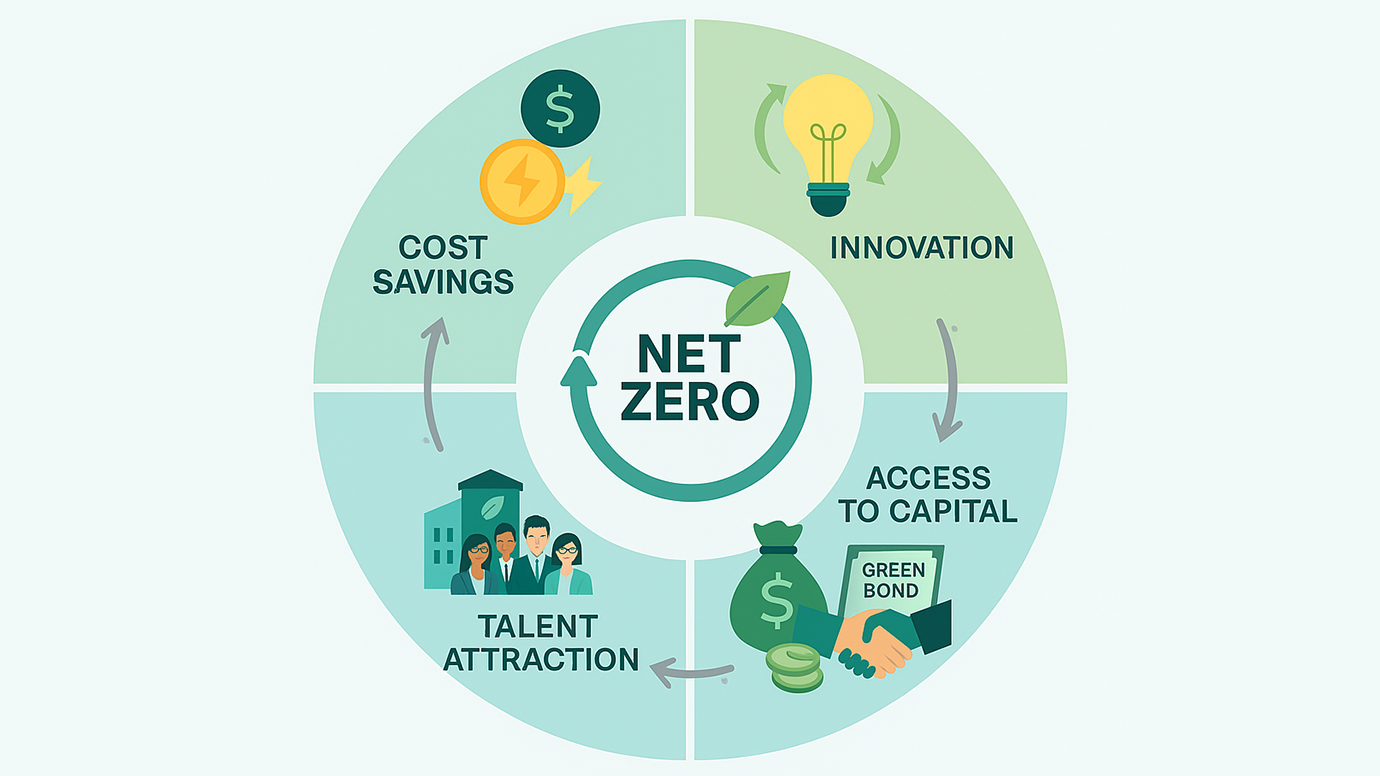
1. Cost Savings Through Energy Efficiency and Renewables
Reducing energy waste and investing in renewable sources is one of the fastest ways for businesses to cut costs while lowering their carbon footprint. From energy-efficient machinery to solar-powered net zero buildings, companies are finding that sustainability directly improves their bottom line. A net zero energy building, for example, generates as much clean power as it consumes, resulting in long-term savings and a significant reduction in zero carbon emissions.
2. Innovation & New Revenue Streams
The push toward net zero carbon emissions is inspiring businesses to reimagine products, services, and processes. By creating zero carbon solutions and launching sustainable offerings, companies can tap into growing consumer demand for environmentally responsible choices. Whether it’s green manufacturing, circular supply chains, or developing net zero energy solutions, the opportunities for innovation are endless. In many industries, being a pioneer in sustainability means capturing market share before competitors catch up.
3. Access to Capital & Green Financing
Financial institutions and investors are rewarding companies that demonstrate credible net zero strategies. Access to sustainability-linked loans, green bonds, and ESG-focused investment funds is expanding rapidly. Businesses that commit to lower carbon emissions and showcase measurable progress toward net zero emissions often enjoy preferential financing terms and stronger investor confidence. This financial edge enables growth, expansion, and the ability to fund large-scale zero carbon footprint projects.
4. Attracting & Retaining Top Talent
Today’s workforce — particularly younger professionals — wants to align their careers with organizations that have purpose. Companies committed to net zero not only appeal to environmentally conscious employees but also foster pride and loyalty among their teams. Showcasing projects such as net zero buildings demonstrates that an organization is serious about contributing to a zero carbon future, making it a more attractive place to work.
By moving beyond compliance and treating net zero emissions as a driver of opportunity, businesses can unlock cost savings, fuel innovation, attract capital, and inspire their people. In doing so, they don’t just achieve a zero carbon footprint — they create a sustainable and profitable path for the future.
Roadmap to Net Zero: How Businesses Can Get Started
Achieving net zero may sound complex, but with a clear roadmap, businesses can take structured steps toward long-term success. Transitioning to net zero emissions is not about making one big leap — it’s about consistent progress in reducing and ultimately eliminating your carbon footprint. Here’s how companies can begin:
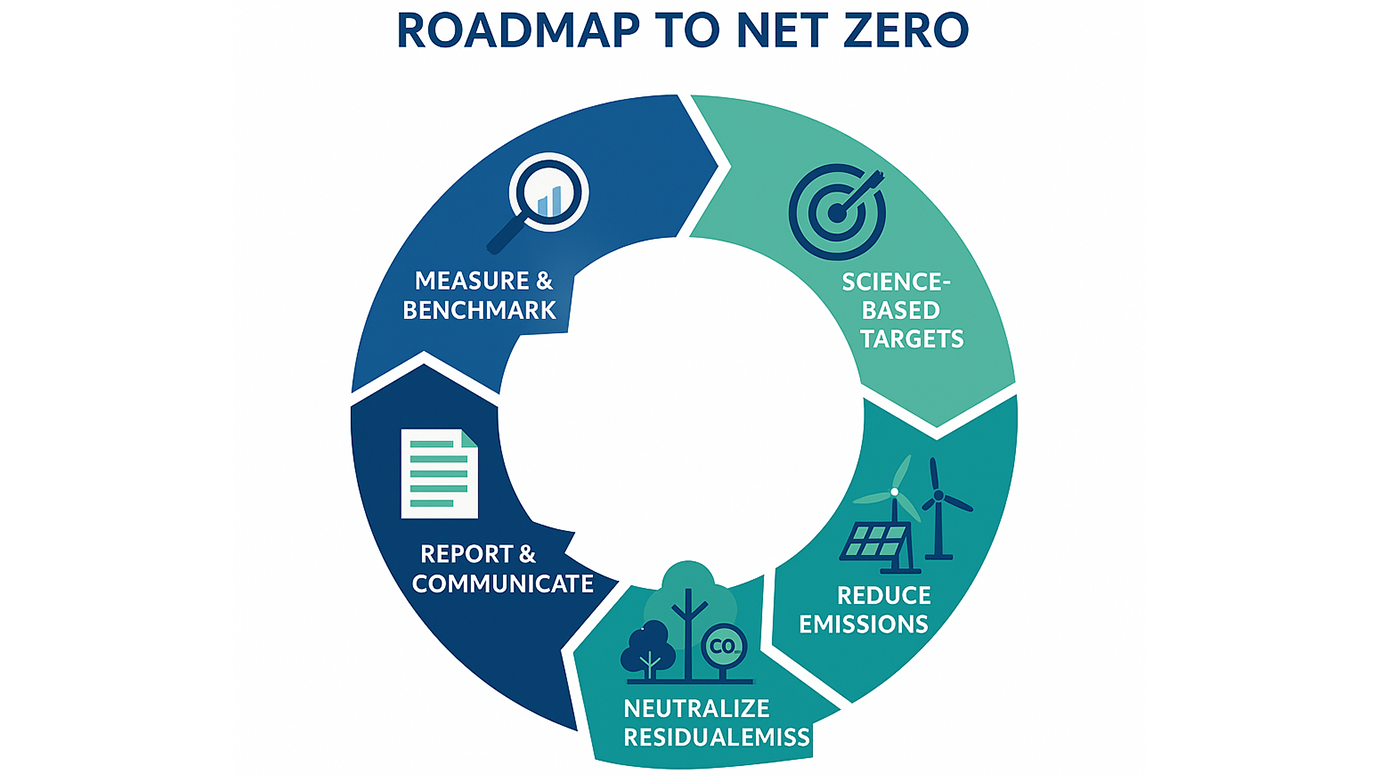
Step 1: Measure & Benchmark
The journey starts with understanding where you stand today. Businesses must conduct a comprehensive carbon footprint assessment, covering Scope 1, 2, and 3 emissions. This baseline provides insights into direct emissions (fuel and operations), purchased electricity, and value-chain activities. Without accurate measurement, it’s impossible to plan effectively for lower carbon emissions or set realistic targets.
Step 2: Set Science-Based Targets
Once the data is clear, the next step is to commit. Align your goals with internationally recognized frameworks like the SBTi Net Zero Standard or national climate strategies. Setting clear targets for zero carbon emissions demonstrates accountability to regulators, investors, and stakeholders. Ambitious but achievable goals also ensure your business stays aligned with the global shift toward net zero energy economies.
Step 3: Reduce Emissions
Reduction is the backbone of any credible strategy. This involves improving energy efficiency, transitioning to renewable power, electrifying operations, and adopting circular economy practices. For industries, this could mean investing in a net zero building that integrates renewable sources and smart design to consume less and generate more. Supply-chain engagement is equally critical, as upstream and downstream activities often represent the largest share of zero carbon impact.
Step 4: Neutralize Residual Emissions
Even with the most aggressive action, some emissions remain unavoidable. That’s where neutralization comes in. Businesses can invest in high-quality removals or offsets that adhere to globally recognized standards (ICVCM/VCMI). From reforestation projects to advanced carbon capture, these strategies balance out the remaining emissions and move organizations closer to true net zero carbon emissions.
Step 5: Report & Communicate Progress
Transparency builds trust. Publishing transition plans, ESG reports, and updates on your journey to net zero emissions demonstrates credibility. Whether you’re showcasing a net zero building initiative or renewable adoption, clear communication ensures stakeholders see both your ambition and your accountability.
A roadmap to net zero is not just a sustainability strategy — it’s a competitive advantage. Businesses that measure, reduce, neutralize, and communicate effectively are not only reducing their zero carbon emissions but also unlocking opportunities for innovation, cost savings, and stronger stakeholder relationships.
Why Starting Early Matters for Net Zero
Transitioning to net zero is a journey that all businesses will eventually need to take — but those who begin early reap the greatest rewards. Here are the key reasons why acting now is essential:
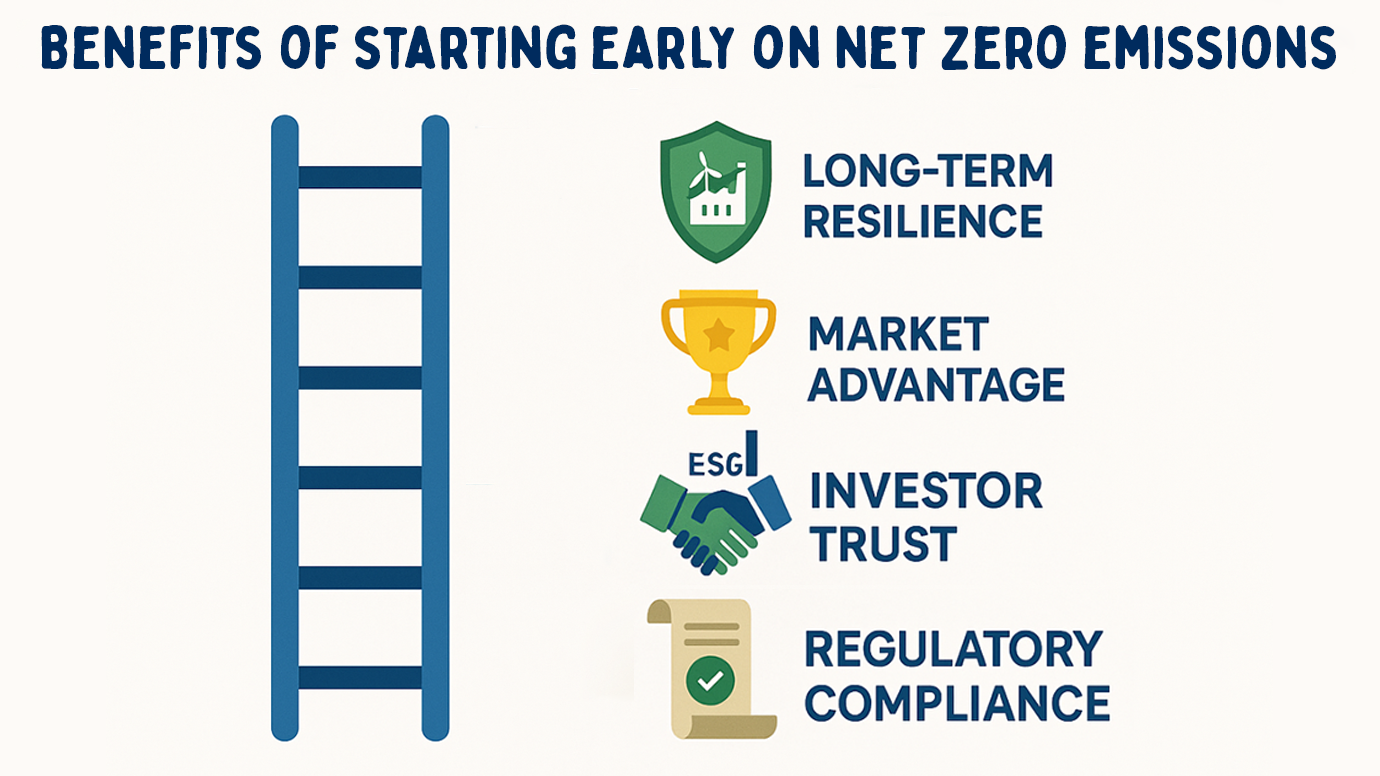
Gaining a Competitive Advantage
Early movers in the net zero emissions transition position themselves as leaders in their industries. By committing to lower carbon emissions ahead of regulations, businesses can:
- Differentiate their brand with sustainability credentials.
- Win contracts with multinational companies that demand zero carbon emissions from suppliers.
- Launch innovations such as net zero energy solutions, which demonstrate efficiency and forward-thinking design.
Customers and clients increasingly value companies that contribute to a zero carbon footprint, meaning early adopters enjoy stronger reputations and lasting loyalty.
Preparing for Regulatory Tightening
Governments worldwide are rolling out stricter climate policies. From ESG disclosure requirements to carbon pricing, businesses will soon have no choice but to align with the targets of net zero carbon emissions. Acting early allows companies to:
- Spread investments in sustainability over time instead of absorbing sudden costs later.
- Avoid penalties, supply-chain exclusions, or compliance delays.
- Build a proactive strategy that aligns with future standards, including net zero energy building codes and climate-related financial reporting.
In short, adopting zero carbon practices now makes regulatory compliance smoother, cheaper, and less disruptive.
Meeting Client and Investor Expectations
The question is no longer if businesses will pursue net zero — it’s when. Clients, investors, and stakeholders are increasingly asking: “What’s your net zero plan?” Companies that act early can:
- Gain access to green financing and sustainability-linked loans tied to net zero emissions progress.
- Strengthen investor confidence by showcasing measurable lower carbon emission strategies.
- Secure long-term partnerships with buyers that prioritize zero carbon footprint products and services.
By presenting a credible roadmap to net zero carbon emissions, businesses demonstrate resilience, accountability, and future-readiness.
Building Long-Term Resilience
Starting early isn’t just about seizing opportunities — it’s about mitigating risks. Businesses that invest in zero carbon emissions strategies today reduce their exposure to:
- Rising fossil fuel costs and energy price volatility.
- Climate-related disruptions such as extreme weather events.
- Reputational risks linked to inaction on climate issues.
The earlier companies begin, the better prepared they are to face an uncertain future with confidence.
Starting early on the path to net zero creates a powerful advantage. Businesses that act today gain competitiveness, regulatory readiness, stronger investor trust, and long-term resilience — all while contributing to a sustainable, zero carbon future.
Sector-Specific Insights: Pathways to Net Zero
While the goal of net zero is shared across industries, the journey looks very different depending on the sector. Each industry faces unique challenges and opportunities in reducing emissions, but all can benefit from structured strategies that deliver long-term competitiveness and sustainability. Let’s explore how key sectors are approaching the transition to net zero emissions:
Manufacturing & Engineering
The manufacturing sector is at the forefront of the push toward net zero carbon emissions. Factories are high-energy environments, and every process offers opportunities for lower carbon emissions. Key strategies include:
- Energy efficiency upgrades — optimizing equipment and processes to minimize waste.
- Renewable integration — adopting solar, wind, and other clean energy sources to power facilities.
- Digital factories & Industry 4.0 — using automation, IoT, and AI to track, analyze, and reduce energy use.
- Green infrastructure — designing and operating net zero buildings that produce as much energy as they consume.
By embracing these innovations, manufacturers can shrink their carbon footprint while improving productivity and cost efficiency.
Supply Chains
For many businesses, the majority of emissions occur outside their direct control — within their suppliers and distributors. Managing Scope 3 emissions is therefore critical to achieving net zero. Steps include:
- Supplier engagement — collaborating with partners to reduce carbon emissions across the value chain.
- Sustainable logistics — transitioning fleets to electric or alternative fuels and optimizing routes for efficiency.
- Transparency & accountability — requiring suppliers to measure, report, and commit to targets of lower carbon emissions.
Building a resilient supply chain that aligns with net zero emissions not only reduces risks but also makes businesses more attractive to global clients who demand zero carbon footprint accountability.
Heavy Industry (Cement, Steel, etc.)
Heavy industries are among the hardest sectors to decarbonize, yet they are crucial for achieving net zero carbon emissions globally. Traditional processes in cement and steel production release massive amounts of CO₂, making innovation essential. Solutions include:
- Carbon Capture, Utilization, and Storage (CCUS) to capture unavoidable emissions.
- Hydrogen-based production to replace fossil fuel inputs.
- Alternative materials and circularity to cut reliance on high-emission raw materials.
- Energy-efficient kilns and furnaces powered by renewables.
By investing in these technologies, heavy industries can drastically reduce carbon emissions, lead in innovation, and move closer to achieving a sustainable zero carbon footprint.
Every sector has a unique path to net zero emissions, but the common denominator is action. Whether it’s designing a net zero building, transforming supply chains, or decarbonizing heavy industry, businesses that innovate today will secure their place in a zero carbon future.
FAQs
A. Net zero means balancing the greenhouse gases a business emits with the amount removed from the atmosphere. For companies, this involves reducing emissions as much as possible and then offsetting the rest through credible solutions.
A. Net zero emissions are essential because they help businesses meet regulatory requirements, attract investors, and build resilience against climate risks while positioning themselves as leaders in sustainability.
A. Companies can achieve lower carbon emission levels by improving energy efficiency, adopting renewable energy, modernizing equipment, and optimizing supply chains to reduce waste and fuel consumption.
A. Carbon neutrality usually involves offsetting emissions, while net zero carbon emissions require businesses to significantly reduce emissions first and only offset the minimal remainder through verified removals.
A. A net zero energy building demonstrates innovation by producing as much energy as it uses, reducing long-term operational costs while contributing to a company’s sustainability and competitiveness.
A. A zero carbon footprint can be measured through a detailed carbon assessment that tracks Scope 1, 2, and 3 emissions, allowing businesses to identify reduction opportunities and progress toward sustainability goals.
Conclusion
The journey to net zero is often misunderstood as a financial burden, but in reality, it is a powerful opportunity for transformation and long-term growth. Businesses that commit to achieving net zero emissions not only reduce their environmental impact but also unlock efficiencies, access new markets, and build stronger trust with stakeholders.
From designing net zero buildings and implementing net zero energy solutions to driving innovation in manufacturing, supply chains, and heavy industries, the path to sustainability opens doors to reduced costs, improved resilience, and enhanced competitiveness. Each step toward lower carbon emissions contributes to building a sustainable economy where companies thrive while leaving behind a smaller carbon footprint.
Importantly, moving toward net zero carbon emissions is no longer a choice but a necessity. Regulators, investors, and customers are all asking the same question: “What’s your net zero plan?” Businesses that can demonstrate measurable progress in reducing carbon emissions will define the markets of the future and establish themselves as industry leaders.
Ultimately, net zero is not just about compliance — it is about shaping a future where innovation, profitability, and sustainability go hand in hand. Companies that act now are building resilience against climate and market risks while seizing opportunities to lead in a zero carbon world.
If your organization is exploring how to reduce its carbon footprint, create a roadmap for net zero energy buildings, or design a strategy to achieve net zero carbon emissions, expert guidance can make all the difference. For tailored business consultation related to net zero strategies and sustainable transformation, you can connect with us.
To learn more about innovative sustainability solutions and business transformation strategies, explore our Homepage.

